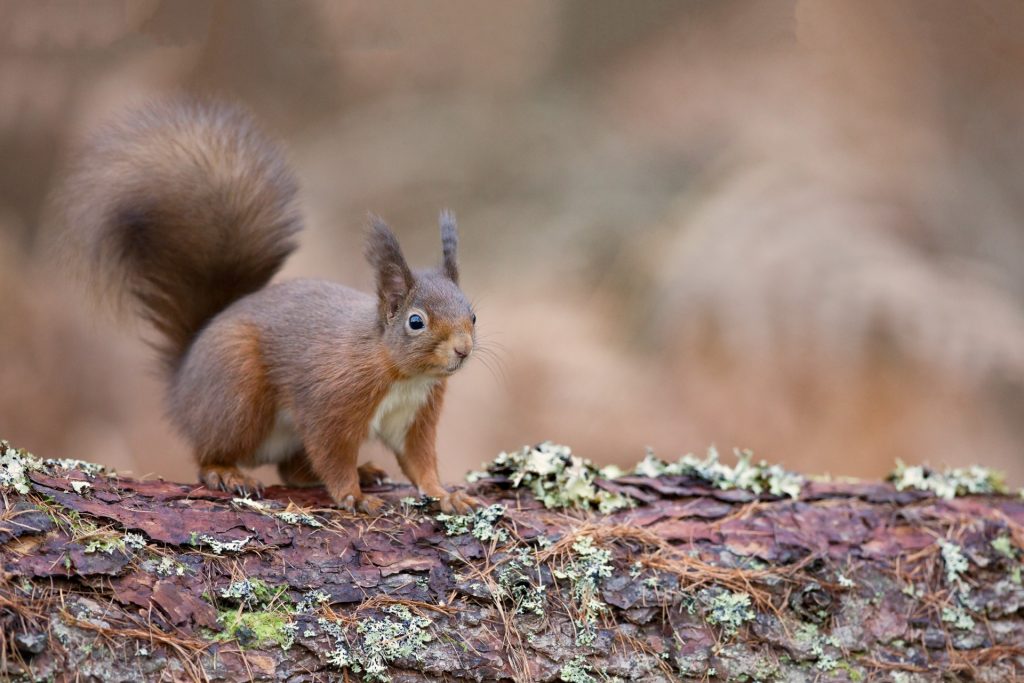South Scotland
Managing squirrelpox to ensure red squirrels continue to have a home in south Scotland
Red squirrels were once widespread across the woodlands of south Scotland, but their numbers fell rapidly upon the arrival of grey squirrels. Since their introduction to urban gardens and parks by humans in the late 19th and early 20th centuries, grey squirrels have spread southwards from the Central Belt, completely replacing red squirrels in Lothian, Lanarkshire, Renfrewshire, parts of Ayrshire and parts of the Scottish Borders.
In 2001 grey squirrels from Cumbria spread north into Dumfriesshire for the first time. Four years later it was discovered that these new arrivals were carrying the squirrelpox virus, which had already had a devastating effect on red squirrels south of the border. We now know that squirrelpox is likely to have spread to all grey squirrel populations in south Scotland.
Despite these challenges, red squirrels are still holding on strong in many parts of Dumfries & Galloway and the western Scottish Borders. The main aim here is to prevent the further spread of squirrelpox, by keeping grey squirrel numbers low enough to reduce the chance of grey squirrel passing the disease to local red squirrels. Efforts here are focused on ten identified Priority Areas for Red squirrel Conservation (PARCs), where previous grey squirrel control work has shown to have kept red squirrel numbers stable.
Thanks to grey squirrel control work by staff, landowners and volunteers, the virus did not spread as quickly to the Central Belt as first initially expected. However, complete containment has proved difficult and the disease continues to slowly expand, with the first death of a red squirrel from squirrelpox north of the Central Belt confirmed in April 2024 just north of Dunfermline, Fife.
Local communities are key to protecting the PARCs. As part of our Lottery funded 2017-24 phases, we helped establish 17 dedicated and enthusiastic volunteer-led Local Network Groups across the region, providing them with the training and support they need to control grey squirrels and monitor, promote and protect red squirrels where they live. These groups now work independently from SSRS, although we continue to support their efforts via our Community Hub and necessary professional grey squirrel control in key areas.
Achievements to date
Increase in grey squirrel control – Analysis of trapping results has shown an increase in grey squirrel detection, largely due to the increase in control activity across the region by volunteers and landowners, with volunteer cull contributions rising from 1.3% to 27% from 2017 to 2021.
Slowing the spread of squirrelpox – The work of SSRS staff and the volunteer networks has significantly slowed the spread of squirrelpox in Scotland and minimised the impact of outbreaks when they do occur, according to scientific modelling work commissioned by NatureScot. This has bought us more time to ensure red squirrels further north are fully protected.
Red squirrel recovery – Analysis has shown that red squirrel coverage has increased or remained stable in the majority of the PARCs in recent years. Co-ordinated, landscape–scale control efforts by staff and volunteers has enabled red squirrels to survive and thrive in many areas where grey squirrels have very high levels of squirrelpox, even in places where red squirrels have previously suffered outbreaks of the disease.
Landowner support – We are helping home and landowners to control grey squirrels on their own and voluntarily support the project’s landscape efforts through our trap-loan scheme. We also support landowners to access Forestry Grant Scheme funding to support grey squirrel control.
Volunteer support – 17 dedicated independent volunteer-led Local Network Groups carry out grey squirrel control across the region, including on vital Forestry and Land Scotland sites. They also carry out essential population distribution monitoring and promote red squirrel conservation.
How you can help
-
- Help us monitor the situation in south Scotland by submitting a squirrel sighting to our website
- Volunteer with your Local Network Group and connect with others working to help red squirrels in your area
- Take action for red squirrels by joining a trap-loan scheme via your Local Network Group
- Help prevent the spread of squirrelpox by cleaning your garden feeders regularly with anti-viral solution
- Send any found dead red squirrels for post mortem to the Royal (Dick) School of Veterinary Studies. Inform your closest Local Network Group that you have done so.
Landowners
Landowners in certain areas can apply for support to control grey squirrels under Forestry Grant Scheme funding, or join a local trap-loan scheme. Woodland owners, meanwhile, can adjust the management of their woods to benefit red squirrels. Please contact your local SSRS or Scottish Forestry staff for more information.
Area Contacts

